Production of Major Carps
Production of Major Carps
The carps are freshwater fishes which contribute about 85% of aquaculture production in India. It has the first position in global freshwater aquaculture production. Commonly cultivated carp varieties are catla (Catla catla), rohu (Labeo rohita) and mrigal (Cirrhinus mrigala) which are of Indian origin and are collectively called as Indian Major Carps (IMC) which depends on different niches of a water body.
Feeding niche of IMC
| Fish | Feeding Space | Natural Feed |
| Catla | Surface Feeder | Zooplankton |
| Rohu | Column feeder | Epiphytes and decayed vegetation |
| Mrigal | Bottom feeder | Benthos and decayed vegetation |
Catla catla

Labeo rohita

Cirrhinus mrigala

In combination with IMC, exotic carps namely common carp (Cyprinus carpio), grass carp (Ctenopharyngodon idella) and silver carp (Hypophthalmichthys molitrix) are also farmed. The benthic omnivore, common carp is a hardy fish which stirs up pond bottom vigorously and feed on benthic fauna and flora. Common carp can withstand injuries as it has an inherent capacity to regenerate injured tissue. Grass carp feeds on and controls aquatic weeds, and its semi-digested matter enhances plankton and serves as food for bottom feeders. Silver carp is a surface feeder, which feeds mostly on phytoplankton while grass carp feeds on vegetation. Among major carps, only common carp breeds naturally in confined waters.
Cyprinus carpio
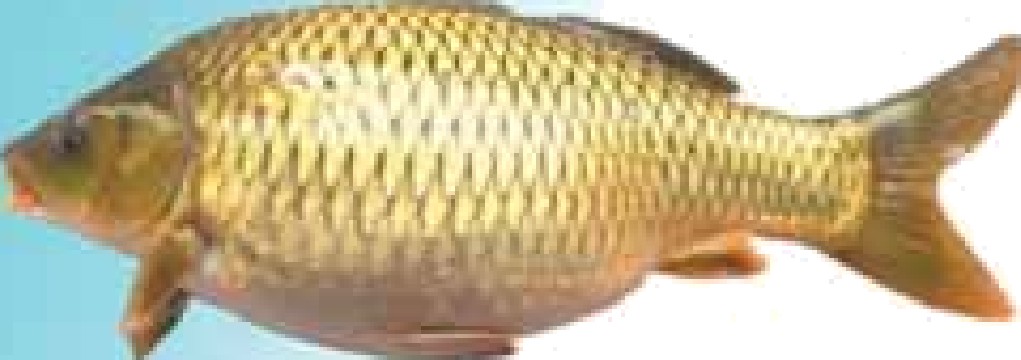
Ctenopharyngodon idella

Hypophthalmichthys molitrix
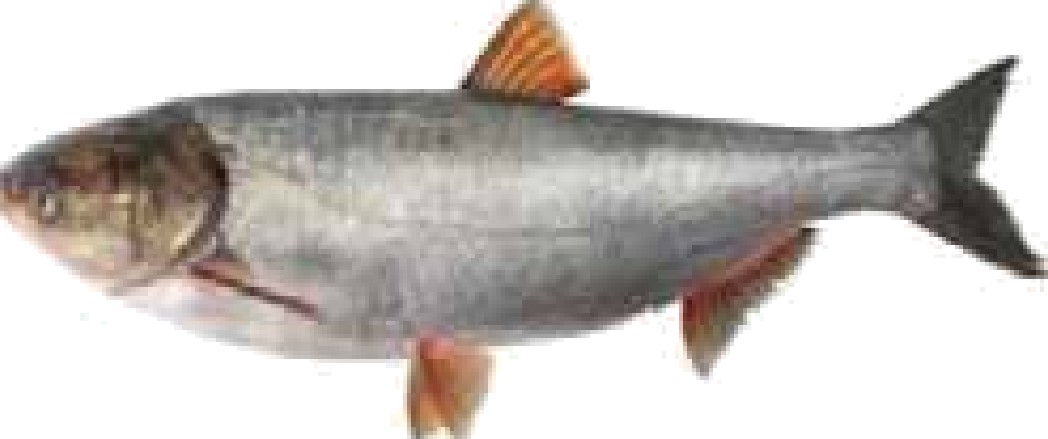
‘Jayanti rohu'and ‘Amur carp’are the genetically improved varieties by natural selection of rohu and common carp respectively which have better growth rate.
Seed Production
Broodstock management
It is the selection and maintenance of mature individuals with desirable hereditary qualities like enhanced gonadal development and fecundity for breeding, thus improving the quality and number of offsprings. Rectangular earthen pond having 0.2-0.5 ha with a water depth of 1.5 m is commonly used to maintain broodstock. Keeping broodfish in raised cement pond is not advisable, as the wider daily fluctuation of temperature may adversely affect the gonad development.
Healthy yearlings without any deformities are selected from different sources to avoid in breeding depression and to promote genetic improvement by out-crossing. Genetic improvement means the production of quality seeds having faster growth rate, better FCR, high disease resistance and better adaptability towards environmental stress. The broodfish is tagged to ensure the breeding between different stocks and to avoid back cross and mating between offspring of the same parent. Tagging of brood helps to identify the source, age and breeding frequency. It is preferable to replace 30-50% of broodfish in every year.
The adult fish is usually transported in a canvas bag with water. The fish brought to the hatchery is disinfected with 40 ppm formalin bath for 2 hours and stocked in ponds at a density of 1500-2000 kg/ha.The provision for running water hastens the maturation process. If there is possibility for aeration or replacement of 20-30% of the water once a month, the stocking density can be further increased. Cowdung at a rate of 250-1000 kg/ha is applied fortnightly to maintain Nitrogen- Phosphorus-Carbon (NPC) ratio as 16:1:106, which ensures sufficient live feed. The broodstock is fed daily at 3% of the bodyweight from February to April and is reduced to 2% of the bodyweight from May onwards. The broodfish is fed twice daily at 6-8 hours interval during daytime with floating pelletted feed (6-8 mm diameter) having 30-35% protein and 10-12% fat, sprouted grain and a formulated diet containing groundnut oil cake and rice bran in 7:3 ratio with nutritional supplements (10 g Vit C, 3 g Vit E, 100 g trace elements and 1.5 kg common salt in 100 kg feed).
The broodstock pond must be free from aquatic weeds or other unwanted fish. The pond is drained once in a year and disinfected by chlorination with bleaching powder (35ppm). The infestation of broodfish with ectoparasites like Argulus and Lernea may be controlled by manual or biological means. Use of chemicals can have adverse effect on gonadal development.
Multiple breeding of carps is possible with scientific pond management and feeding practices. The broodfish bred once during the previous season is used for multiple breeding upto four times in the next year with an interval of 40-45 days. In the case of repeated spawning, spent fish is disinfected by 5 ppm KMnO4 dip and kept in a separate pond and fed at 5% of the bodyweight for the first week.
Water quality management
To operate a hatchery having the capacity to incubate 20-30 lakh eggs at a time, an over-head-tank of 20 t capacity and an open well or a tube-well (20 t/hr yield) with two water pumps and a generator are required. Presence of a water body in the vicinity is desirable. If surface water is used, suspended particles are allowed to settle, and the water is then passed through a sand filter to remove particles larger than 25pm. The suspended particles may form a coating over eggs or chock the gills of fry. In case of water scarcity, facilities for reuse of water after filtration through screen filter, biofilter, foam fractionators and sand filters are set up. The water should have total alkalinity of 40-100 ppm and iron content of less than 0.4 ppm. The alkalinity of the water can be reduced by adding alum (Every excess 1 ppm alkalinity requires 1 ppm alum), while it can be enhanced by dolomite @ 2-4 g/m'.
Selection of breeding pair
Generally, IMC and silver carp breed during south-west monsoon, but common carp breeds almost throughout the year with two peaks during June to August and January to March. Grass carp spawns during March to August. As carps are sexually dimorphic, the broodfish are segregated according to sex. Secondary sexual characters usually develop during March and broodstock are segregated and kept @ 1000 kg/ha. The mature male is distinguished by the roughness on the dorsal surface of the pectoral fln. The abdomen of male is comparatively flat, and the vent is not swollen. On applying slight pressure on its belly, milt oozes out. The ripe female of IMC and common carp have soft and bulging abdomen with a swollen pinkish genital opening. The female of Chinese carps is distinguished by visual examination of the ova collected by inserting a catheter through the genital opening. The mature ova measure 1.2-1.3 mm diameter which has pale blue colour in silver carp and yellow to deep golden brown colour in grass carp.
Optimum age and weight of broodfish
| Variety | Optimum age | Minimum weight (kg) |
| Catla | 3-5yrs | 2.5 |
| Rohu | 2-5yrs | 2.0 |
| Mrigal | 2-5yrs | 1.5 |
| Grass carp | 3-5yrs | 2.5 |
| Silver carp | 2-5yrs | 2.0 |
| Common carp | 1-5yrs | 1.5 |
Spawning
Spawning includes courtship, releasing of gametes and fertilisation. The success of spawning primarily depends on water quality and weather. The optimum water temperature is 26-28°C with drizzling weather. Water containing 5-6 ppm DO promotes spawning and hatching. Male and female are usually selected in a ratio of 2: l by number or 1:1 by bodyweight. The selected broodfish are handled with minimum stress and kept in breeding hapa or breeding pool for about 6 hours. In a breeding pool, never put different species together.
Breeding hapa is made of fine-meshed net cloth having the size varying from 3.6 m x 1.5 m x 0.9 m to 1.8 m x 0.9 m x 0.9 m depending on the size of the brood. The hapa net is tied to the poles fixed in the water column at both upper and lower corners using laces stitched to it and placed in a fully stretched out condition. Care should be taken to ensure that the bottom of the hapa is not touching the bottom of the water body, and there should be at least 20 cm height above the water surface. For the introduction of broodfish, there is an opening at one end of the hapa, which can be closed by flap or zip.
The breeding pool is circular and made of cement having 6-12 m diameter. The depth at the periphery is 120 cm and the bottom slopes towards the centre. The depth at the centre is 150 cm where there is an outlet pipe having 2-3 inch diameter. The wall of the breeding pool is fitted with duck-mouth inlet pipes fitted at an angle of 45° to create circular water flow. Over-head water showering at the height of one meter is provided with the breeding pool. Water is brought to this pool from an over-head-tank through 2-3 inch diameter pipe. The water depth inside the pool is maintained at 60-100 cm. Small breeding pool made of FRP/polythene-sheet having 4-6 m diameter and 1 m height is also widely used.The breeding pool is cleaned and disinfected with 50 ppm sodium hypo chlorite solution before and after each operation. The broodfish in the pool is kept under the shower before and after hormone injection.
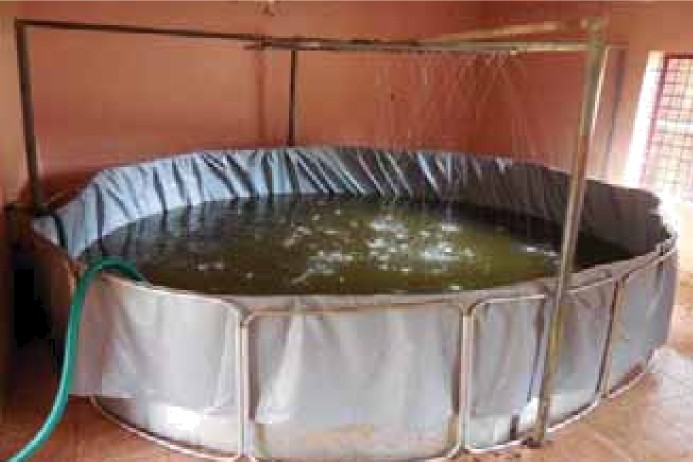
After proper conditioning, individual broodfish is collected, weighed, placed on a soft cushion and injected in the evening with synthetic hormones like Wova-FH, Ovatide or Ovaprim. Intra-peritoneal injection through the inner side of the pectoral fin base or Intra-muscular injection either on the dorsal part of caudal peduncle or in the dorsal muscle above the lateral line and below the anterior part of the dorsal fin is usually practiced. Intra-peritoneal injection is preferred as it provides minimum stress to the fish. Care should be taken not to prick through the scale while giving the injection. The dosage of synthetic hormone depends on the size and age of broodfish, readiness for spawning, bulkiness of ovary and sensitivity of the broodfish. The optimum dosage of synthetic hormone is given below:
- Catla, Rohu : 0.5 ml/kg
- Mrigal, Common carp : 0.3 ml/kg
- Grass carp, Silver carp : 0.6 ml/kg
The size of the needle depends on the weight of the fish to be injected and it is given below.
- 1- 2 kg : Number 24
- 2-3 kg : Number 22
- >3kg : Number 19
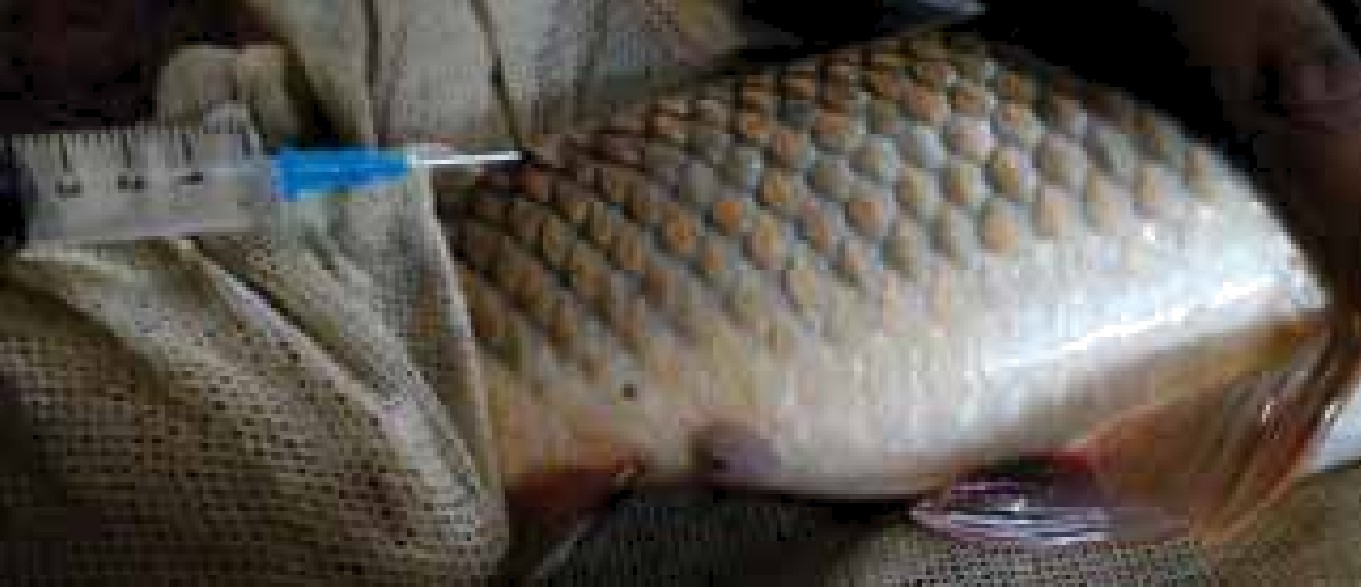
After injection, both male and female are kept in hapa or breeding pool at a density of 3-5 kg/m3 for spawning. After 3 hours of injection, circular water current is provided at 0.2-0.5 mls. An environment free from stress, human and mechanical interference is required for better success rate. Under the influence of hormone and water current, the broodfish starts courtship. Male starts to chase the female with the splashing of water which creates irregular ripples on the water surface. In the case of IMC, towards the end of courtship, male hits the female's abdomen with its head. The female starts laying eggs, and the male continuously oozes milt to fertilise the eggs. All eggs from the ovary will not be laid at one place or at one time as the pair keeps on moving.
Usually, the response time for courtship is 4-6 hours after injection and lasts for l -2 hours. Soon after spawning, water flow is stopped, and the spent broodfish is collected back. The average range of fecundity of fish is given below.
Catla 0.5-2.0 lakh/kg
Rohu 1.0-3.9 lakh/kg
Mrigal 0.5-1.9 lakh/kg
In the case of IMCs, the fertilized eggs appear like beads after water hardening and are non-adhesive and semi pelagic. The fertilised egg is transparent, whereas the unfertilised egg appears opaque and whitish. The delay in removing unfertilised eggs causes Saprolegnia infection which can be controlled by using malachite green (20ppm) for 20-25 minutes after stopping the water flow. After 8-10 hours of fertilisation, the embryo exhibits twitching movements and the fertilised eggs are volumetrically quantified using a cup or beaker and transferred to the incubation pool. The number of water hardened eggs in one-litre water is about 25,000 for catla, 30,000 for rohu and 20,000 for mrigal. Fertilisation rate is determined by taking egg samples. The usual fertilization rate is 85%.
In silver carp and grass carp, the dry method of stripping is practiced for fertilising the eggs. Before stripping, the fish is anaesthetised by l00ppm ethyl-m-aminobenzoate bath for 3-5 minutes. The female is wrapped in a towel and stripped by gently squeezing the abdomen towards the tail to collect ova in a dry enamel tray or plastic basin and immediately fertilised by milt stripped from male using a feather. The eggs begin to swell on contact with water and attain 4.2 - 4.7 mm diameter. More water should be added so that there will be 3-5 cm of water above the eggs. The water hardening of eggs will be completed within 30 minutes. It is then washed in water 3 - 4 times and put for incubation. Fecundity per kg body weight of grass carp is 0.13 - 0.82 lakh, and that of silver carp is 1.3-1.7 lakh.
In common carp, conditioned male and female in the ratio 1: lare put in hapa or cement cistern during the evening, and it naturally breeds after 6 - 8 hours, if suitable substrates are provided for the attachment of adhesive eggs. Natural substrate like Hydrilla, after thorough washing, is provided at the rate of 2 kg for 1 kg fish. However, artificial substrate like synthetic net pieces is preferred as it does not decay in water and can be used again. The substrates attached with eggs are collected in the next morning, washed gently to remove debris and kept for incubation. Salt, urea or skimmed milk powder is used to avoid clumping of eggs. Fecundity of common carp is 1-2 lakh/kg bodyweight.
Incubation
Incubation is the process of maintaining fertilised eggs under suitable conditions for hatching, and it is done in a double-walled hatching hapa or circular hatching pool. The hatching hapa is double-layered nylon net with an outer net having a mesh size of 0.5 mm and inner net having a mesh size of 2-2.5 mm. Both the hapas are flxed in the margin of pond by means of poles. In the inner hapa, eggs upto 50,000/m' are kept for incubation. After hatching, the hatchlings alone move out through the mesh of the inner hapa, and it is collected in the outer hapa. The empty eggshells are left in the inner hapa which is removed along with the inner hapa after the hatching is completed.
The circular incubation pool has two chambers. The outer chamber of 3m diameter is constructed with cement, FRP or plastic material and inner chamber of 1.5m diameter is built with net of 320-420qm mesh size, permitting out-flow of water. If the outer chamber of the incubation pool automatically receives eggs from the spawning pool, the opening of the inlet pipe should be 30 cm above the base of incubation pool to prevent injury of eggs. In a circular incubation pool of 3 m diameter, 20- 30 lakh eggs are incubated in the outer chamber at once.
Water enters through showers and through 6 - 12 duck mouth valves fitted equidistant in a row on the floor of the outer chamber and a water depth of 80 cm is maintained by overflow facility. The unidirectional continuous water flow in the pool keeps the fertilised eggs evenly distributed and slowly rolling in the water column without settling on the floor or sidewall and helps in removing the metabolic wastes like ammonia and carbon dioxide.
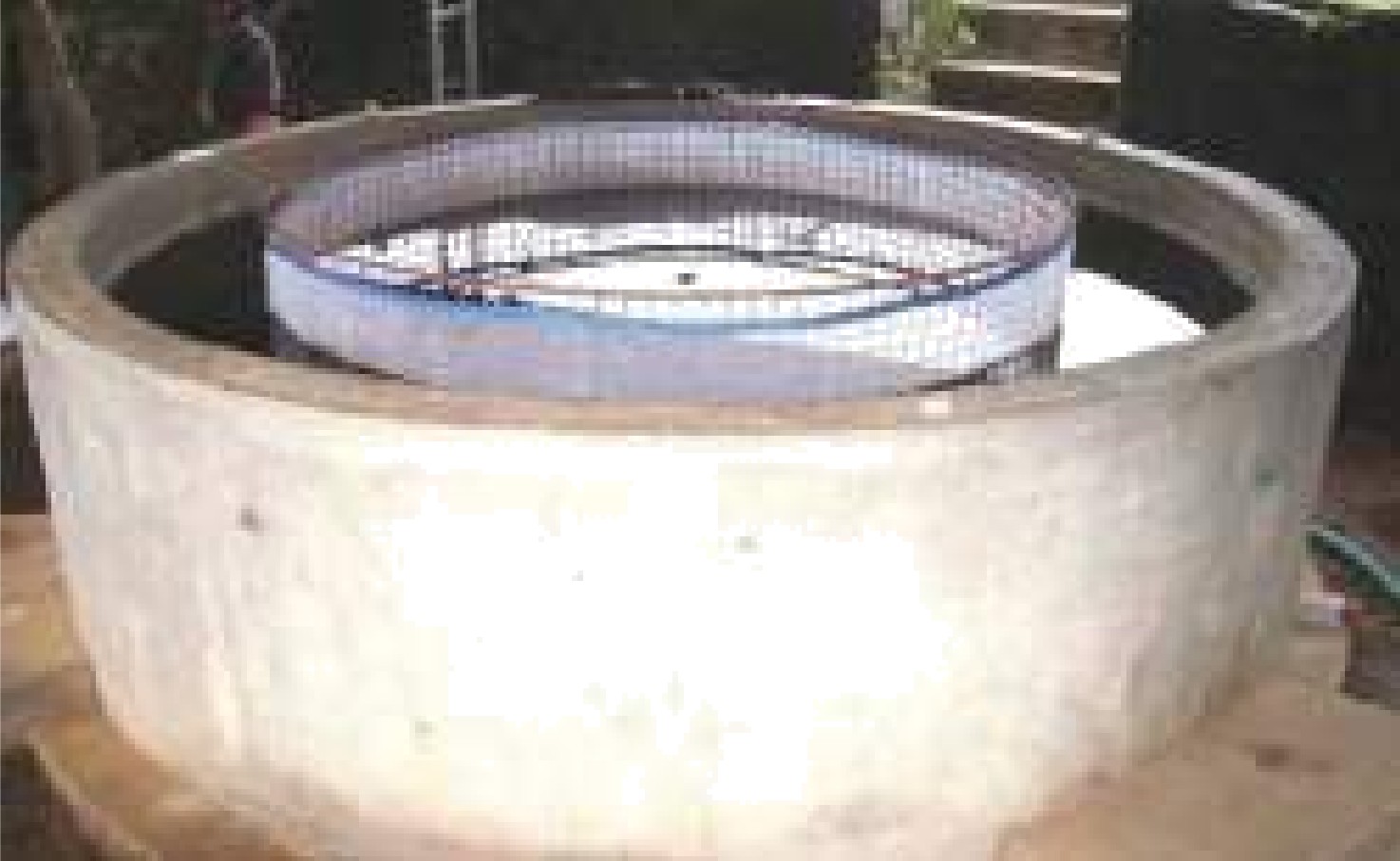
The water flow is maintained at 2.5 l/s for initial 12 hours and reduced to 2 l/s when the embryo inside the egg starts to move. After 6 hours, the water flow is again increased to 3.0-3.5 l/s. A clean bamboo stick of 2 cm width is kept on water surface across the chambers to accumulate and remove the floating foam, debris and insects. The column debris including dead spawn and egg shell can be periodically removed by keeping 5-6 pieces of coir rope of lm long with smooth bristles tied with bamboo stick. The rate of hatching is usually 95% in the circular pool, while 75% in hapa.The hatching time is as given below,
IMC 14-20 hr
Chinese carps 24-36 hr
Common carp : 48-72 hr
The average length of the hatchling is 4.7 mm for catla and 4.2 mm for rohu and mrigal. They are slender, transparent and non-pigmented with club-shaped yolk on the ventral side of the trunk. They have no mouth and fins, but embryonic fin fold can be seen. Soon after hatching, they lie laterally at the bottom and comes up occasionally. They start vertical movements after 12 hours of hatching, and the eyes become pigmented. Pectoral fin is developed by 24 hours after hatching and shows slight darting movement. Mouth, operculum, stomach and intestine appear within 48 hours and the larvae exhibit shooting and darting horizontal movement.
Till the yolk is utilized, larva doesn't feed on exogenous food and remains in the same pool or hapa. The yolk-sac is usually fully absorbed by 72 hours for rohu and mrigal and 96 hours for others but it is reduced to 60 hours in multiple spawning. After yolk absorption, the larva starts to feed on microalgae and zooplankton (ciliates, rotifers, cladocerans and copepods). The hatchlings are measured using measuring cups and collected for nursery rearing. The count of hatchlings ranges from 600- 650 no./ml.
Nursery pond design
It involves initial nursery rearing of the 3 - 4 days old hatchlings (5-8 mm) into fry (25 mm) and the subsequent nursery rearing of fry (25 mm) into fingerling (>40 mm). Drainable cement tank with 200 m2 area and 150 cm depth with a soil layer of 5-15 cm having bottom slope towards the outlet is ideal for nursery rearing. The pond is covered with 50-100 mm mesh size netting to control predatory birds. If the pond is below ground level, the side of the pond is fenced with a net of 26 mm mesh size to prevent the entry of predators.
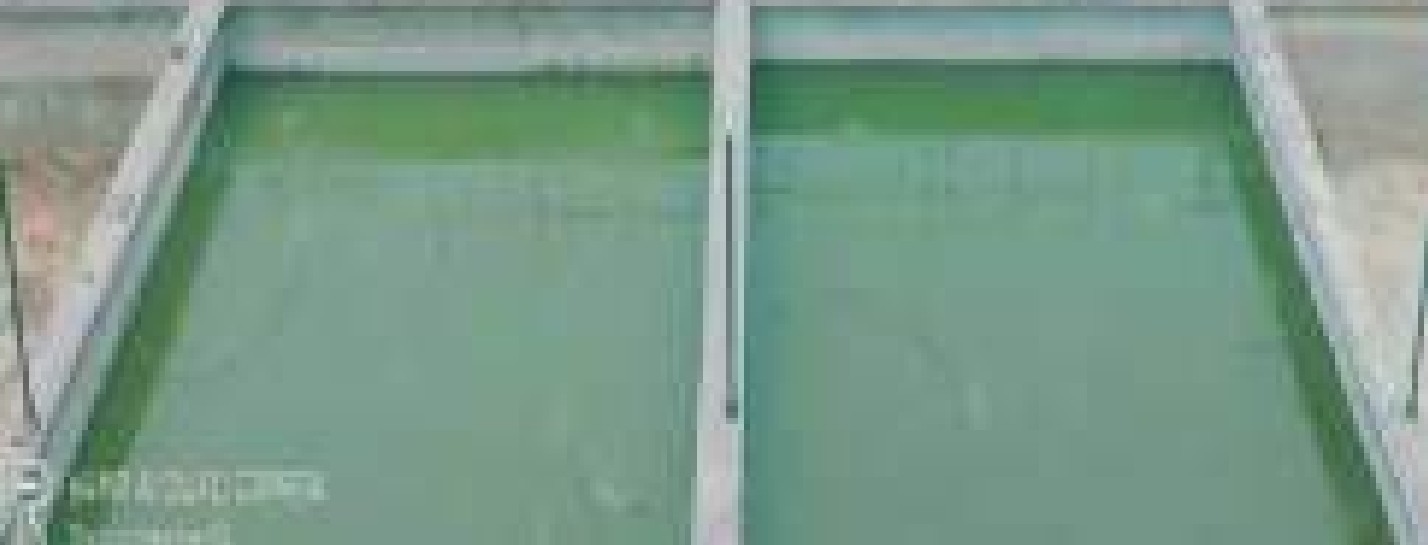
For providing keel aeration, each 200 m2 pond is provided with 14 pieces of algal resistant aero-tube rings of one meter lenght with half- inch inner diameter and each aero-tube ring is provided with 1.5 inch PVC pipes loaded with sand inside and sealed at both ends. Two air blowers of (roots type) 5 hp (300 m3/hr) is required for 10 numbers of 200 m2 ponds for providing aeration continuously through these aero- tube rings. The blower should be placed close to the pond at a height above the water level to prevent the reverse flow of water.
Seasonal earthen pond of 200-1000 m2 with a water depth of 70-100cm is also used for seed rearing. The surrounding area of the pond is kept free from the dense growth of vegetation by frequent weed cutting using brush cutters. Seed rearing is also practiced in open water bodies by installing hapa or cage made of close-mesh netting.
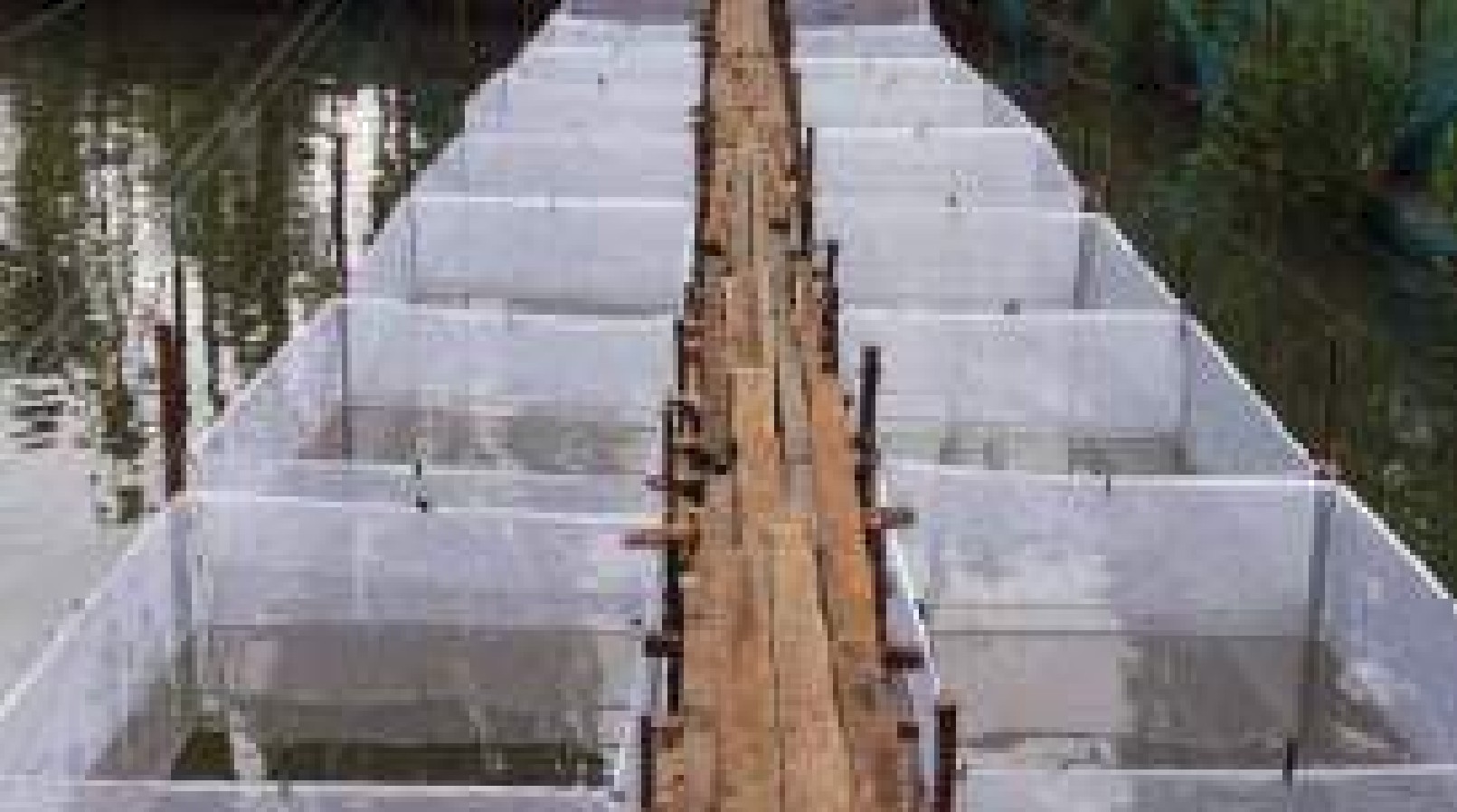
Nursery pond preparation
Eradication of aquatic weeds, predatory and weed fishes and liming is done as explained in grow-out farming.
Live feed production
The outdoor nursery tank is filled with the filtered water, enriched with inorganic fertilizers (60 g ammonium sulphate, 10 g urea, and 10 g superphosphate in 1000 1 water) and aerated well. Cowdung @2000 kg/ha or a mixture of 100 kg fermented (by yeast) groundnut oil cake, 200 kg cowdung and 75 kg single superphosphate per ha is also used.
In the early morning, microalgae (5-25um) from the indoor lab are inoculated in the tank. They multiply and attain maximum density within 7 days and become ready to form food for zooplankton. Then it is inoculated with zoo-plankton such as freshwater rotifer (Brachionus rubens), copepods and cladocerans (Daphnia and Moina) at the rate of 2 no./ml from stock depending on the mouth size of the larvae to be fed (small: 50 - 100 pm or medium: 100 - 200 um length). Zooplankton multiply and become suitable feed of the larvae of fish within 7 days. In larval rearing pond, the optimum level of plankton is 2 ml/50 1 of water which should contain zooplankton at a level of 2-5 no./ml. Large copepod like Cyclops should be avoided. Pure stock culture of desired phytoplankton and zooplankton is specially maintained at the indoor laboratory for the continuous production of live feed organisms. A subsequent dose of cow dung is added at 125-500 kg/ha for every 3 days in accordance with the availability of plankton. Yeast is added as a food source for larvae, but it is mainly fed by zooplankton which is grown for larval culture.
Control of aquatic insect
Aquatic insects like Notonecta, Ranatra, and Cybister and nymph of Dragonfly cause substantial mortality to the hatchlings. Repeated dragging of the pond with fine-meshed net can remove the insects to some extent. Spraying of soap oil emulsion is an effective eradication method. Soap oil emulsion required for one hectare can be prepared by melting 18 kg washing soap in a small quantity of water by mild heating for a shortwhile and then 56 kg vegetable oil is added with constant stirring to form an emulsion. As the emulsion forms a layer at the water surface, it prevents the aerial respiration of insects, but there is no harmful effect on fish seeds or plankton. During calm and non-rainy days, the soap oil emulsion is applied 12-24 hours before stocking.
Stocking in the nursery
The 3-4 days old hatchling is stocked in the early morning or evening. Before releasing into the pond, it is acclimatized as explained in grow-out farming. The stocking density in cement tank provided with continuous aeration facility is 2500 no./m2 for initial nursery rearing (3-4 days old hatchlings into fry stage) of 15-18 days and thereafter reduced to 1000 no./m2 for the later nursery rearing (fry stage into fingerling stage) of 25-32 days. The stocking density of seed rearing in an earthen pond is 400 no./m2 and that of hapa or cage installed in large water bodies is 2000-3000 no./m3.
Feeding
Even though hatchling primarily grazes on natural feed organisms, supplementary feed having 40-45% protein is broadcasted all over the pond commencing from the first day of stocking. It is fed four times daily during day time with a supplementary feed consisting of finely powdered groundnut oil cake and rice bran fortified with vitamins, minerals and micronutrients. Feed probiotic is also given. The quantity of feed is determined as per the quantity given in Table 1.3 and also based on the regular monitoring during consumption of feed.
Feed requirement
| DPH | Feed Size (mm) | Fsily trwuitrmrny/one lakh spawm |
| 4-12 | 0.10 mm | 0.5 kg |
| 13-20 | 0.30 mm | 1.0 kg |
| 21-30 | 0.60 mm | 2.0 kg |
| 31-40 | 0.60 mm | 3.0 kg |
| 41-50 | 0.80 mm | 4.0 kg |
| 51-60 | 0.80 mm | 5.0 kg |
Care and maintenance
Initially the young one has less mobility; hence the water depth is maintained at 40-60 cm at the time of stocking, so that it can find the live feed organism easily. After 4 days, the water depth is slowly increased by 3-5 cm daily. Water quality parameters like pH, hydrogen sulphide, ammonia, nitrite and nitrate are monitored with the help of testing kits. Also, instruments such as Secchi disc’ for water transparency and DO meter for dissolved oxygen are used. Reduction of DO and build up of ammonia or other toxic substances in the pond are managed by aeration. Continuous sprinkling or exchange of water is preferred, if sufficient quantity of good quality water is available. Water probiotic is used to maintain the water quality during the scarcity of water. In order to condition the bottom soil, application of soil probiotic is also preferred. The hatchery operation may be hindered by power failures, which affect the aeration and water exchange and thereby survival. It may be overcome using diesel-powered power generator.
Harvesting of seed
When the fish seed attains a size of more than 40mm (1g), it is harvested using net having a mesh size of 2mm. The average survival rate of initial nursery phase is 40% and that of later nursery phase is 75%. The harvested seed is starved for one day prior to packing to empty the gut and kept in crowded condition to make it accustomed to the conditions of transport. Usually, conditioning of seed is done in hapa made of mosquito net kept in pond or plastic pool for 12-16 hours at 2000-3000 no./m3. Frequent splashing of water should be done during conditioning.
Packing & transportation
Fish seed can be transported in an open or closed container. In the open system, the seed is usually transported for long distance in 1-3 t plastic tanks with oxygenation or aeration facility. A cylinder of 340 cm3 capacity is required to provide oxygen supply to one-tonne tank per hour. 8 - 10 kg of fish seed can be transported in one-tonne tank with water.
The closed system is a common method of seed transportation where polythene bag of 16-18 1 capacity is used. After filling one-third of the bag with clean water and transferring the seed, the bag is inflated with oxygen in high pressure from a cylinder to fill the remaining two-third of the bag. The upper 10-15 cm of the bag is twisted, tied airtightly and transported in plastic crates. Packing in a double layered bag is practiced to prevent damage during transportation. Bag of 60-80 qm thickness is used for packing egg, spawn, fry and fingerling and that of advanced fingerling is100-150 qm. During transport, ice packets are used between the bags to maintain the temperature. Hatchlings of about 20,000-40,000 numbers can be packed and transported in a bag for 6-12 hours. For 12 hours transportation in a closed bag, the fish seed of 2 cm size is packed @ 1500 numbers, 4 cm size @ 300 numbers, 6 cm size @ 120 numbers and 8 cm size @ 50 numbers.
Composite Culture in Pond
Composite culture means the farming of different species of fishes, which are fast-growing, compatible and having different feeding niches in a single pond, to obtain the maximum yield. Farming of the IMC with Chinese carp and common carp in a pond is an excellent practice of composite fish culture.
Site selection & pond construction
Availability of water, electricity, transportation and marketing facilities should be considered while selecting a site. Polluted areas should be avoided. Clayey loam soil having good water retention capacity is ideal for pond construction. Rectangular pond having an area of 0.05-2 ha with a water depth of 1-2 m is preferred. There is an elevated edge of minimum 30 cm around the pond to prevent the entry of water run-off during rain. The slope of the bund ranges between 1:1 (clayey soil) to 1:3(sandy soil). For proper water exchange, inlet and outlet are installed at diagonally opposite corners of the pond. The long side of the rectangular pond is preferably constructed in parallel to the prevailing wind direction. The pond is covered with 100 mm mesh size net to control predatory birds. The side of the pond is fenced with a stiff net of 26 mm mesh size to prevent the entry of predatory animals such as frog, snake and tortoise and the escape of stock during a flood.
Preparation of pond
The pond is drained completely and dried properly till cracks appear on the pond bottom (usually 15 days). Ploughing is done for tilling the soil to a depth of 30 cm which increases the fertility of the soil. Feeding area, corner and side ditch in the pond is tilled and dried properly to avoid the formation of black soil. The bund is strengthened and the pipe or sluice gate is fitted with close-meshed net to regulate water intake and outflow.
Eradication of aquatic weeds
Aquatic weed reduces the living space and obstructs the free movement of fish and harbours insects which are harmful. It utilizes the available nutrients in the water and causes oxygen depletion during the night. Hence, the aquatic weeds in the pond should be removed manually by handpicking and uprooting. Herbicides like 2,4- dicholorophenoxy acetic acid at 4.5-6.7 kg/ha is used to control floating and emergent weeds and simazine at 6 kg/ha for submerged weeds, but it is not usually advisable.
Eradication of predatory and weed fishes
Predatory fish prey upon the fish seed while weed fish compete for food, shelter and DO. Hence, the predatory and weed fishes present in the nursery pond are removed by dewatering, repeated netting with small-sized mesh (mosquito net), drying and application of fish toxicants. Mahua oil cake (4-6% saponin) at 2500 kg/ha/m kills the fish in 3-10 hours and its toxicity in water lasts for 2-3 days. Ammonium sulphate at 600 kg/ha/m along with quicklime at 1500 kg/ha/m is used to kill all animals, including crustaceans. However, chlorination of pond water at 35ppm using bleaching powder (30% active chlorine) is more effective, but never let-out treated water from the pond into open water body. Chlorination also destroys microbes and parasites in the soil.
Rectification of pH
The pH of soil and water of the pond is checked and rectified by using lime, one week prior to the manuring to accelerate its mineralization. Agricultural lime is usually added to the soil to control the acidity, and its doses with respect to soil pH are given below,
- 4.0-4.5 pH 1000 kg/ha
- 4.5-5.5 pH 750 kg/ha
- 5.5-6.5 pH 500 kg/ha
- 6.5-7.5 pH 250 kg/ha
The lime also acts as a disinfectant by killing microbes and parasites and helps to control the bad effects of humic acid or sulphuric acid, if present. Application of dolomite at 200 kg/ha is ideal for stabilizing the soil pH. In highly alkaline soil (>pH 9), gypsum at 1-10 ppm is applied to rectify the soil pH.
Manuring
To ensure optimum production of plankton, manuring the pond with organic fertilizers such as cattle dung at 2,000-2,500 kg/ha or poultry droppings at 500 kg/ha is applied as an initial dose, 10-15 days prior to stocking. If mahua oil cake is used as the fish toxicant, application of fertilizer can be reduced by half. After 10-15 days of manuring, the colour of pond water turns brownish-green due to the development of both phytoplankton and zooplankton which indicates that the pond is ready for stocking.
Water quality parameters
Optimum water quality parameters are given below,
Temperature : 27-320C Alkalinity : 80-120 ppm
Salinity : <5 ppt TNA : <0.01 ppm
Transparency : 25-30 cm NH4N : 0.08-0.2 ppm
pH : 7.5-8.5 NO3N : 0.04-0.08 ppm
DO : >4ppm P2O5 : 0.04-0.1 ppm
Free CO2 : <5 ppm Iron : <0.3 ppm
Stocking
The pond is filled with a minimum water level of lm prior to seed stocking. At first, the seed is acclimatized to pond water temperature by keeping the seed bag in the same pond for 30 minutes. Then the bag is opened and allowed the slow entry of pond water into it, which helps the seed to get accustom to other water quality parameters. Gradually, the seed swims out voluntarily to pond water.
The stocking density of carps is 0.3-1 no./m2 depending on system of management. In the case of ponds which cannot be drained to remove the predators, the fish seed of 4 cm is stocked in cage, hapa or pen installed in the same pond for further rearing to attain a size of 10 cm over a period of 30-45 days in order to enhance survival rate. In such cases, stocking density of fry for rearing is 100 no./m2 for pen and 250 no./m3 for cage and hapa. Separate earthen pond or tank can also be used for further rearing of seed.
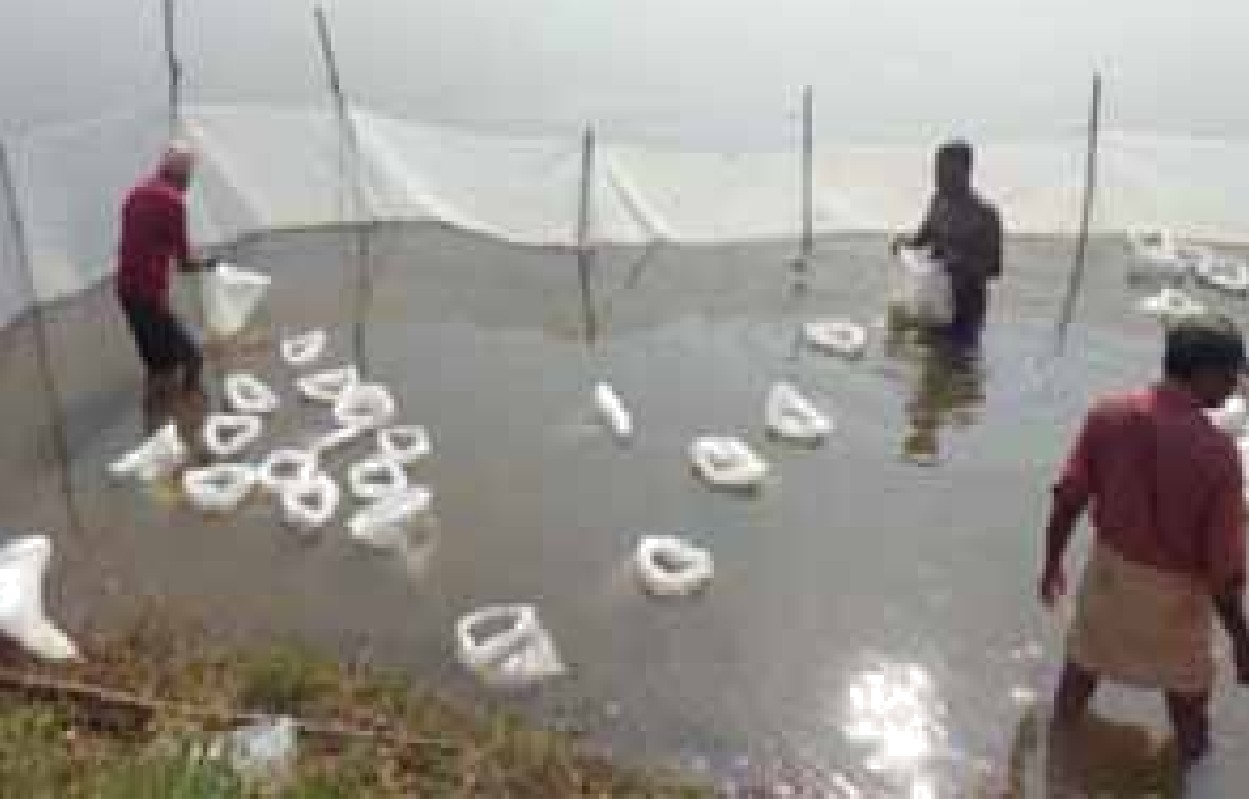
In composite culture practice, various species of carps are stocked together. The proportion of catla and silver carp is stocked at 30-40% while the ratio of mrigal and common carp is 25-35%. The ratio of rohu ranges 15-30% based on the water depth. Grass carp is stocked at the rate of 5-10% based on the availability of vegetation. In the case of carp culture with high stocking density of 0.5-1 no./m2, the ratio of any one species can be enhanced up to 60%. Continuous crops can be taken by keeping another set as stunted fingerlings in cage or pen installed in the same pond. After the harvest of the first crop, the stunted fingerlings can be released into the grow-out pond for second crop. When the stunted fingerlings are used, they show faster growth rate.
Feeding
If the natural feed is available in sufficient quantity by manuring, supplementary feeding can be avoided for the first 3 months of grow-out farming. It can be reduced by 50% for the remaining farming period, which reduces the production cost drastically. In such cases, supplementary feeding with floating pelleted feed having 25-30% protein is ideal for carps, and it is given in the morning at 5% of the bodyweight initially and subsequently reduced to 1% during the last month of culture. Supplementary feeding should be meticulous as excess feeding not only pollutes the pond environment but also escalates the cost of production. The quantity of feed requirement is given in Below Table, but it can be modified based on the growth rate of fish and availability of natural feed organisms.
Feed requirement
| ABW | Protein Content (%) | Feed size (mm) | Daily feeding rate (% of ABW) |
| 3-5 | 34 | 0.8 | 5 |
| 5-25 | 32 | 1.2 | 4 |
| 25-100 | 28 | 1.8 | 3 |
| 100-250 | 24 | 3.0 | 3 |
| 250-500 | 24 | 4.0 | 2 |
| 500-750 | 24 | 6.0 | 2 |
| >750 | 22 | 6.0 | 1 |
If the natural feed is not available in the pond as in the case of intensive farming, the fish is fed twice daily (morning and evening) at 10% of the body weight initially, and it is gradually reduced to 2% of the bodyweight in the final stage. An appropriate feed storage facility, shall be provided with ventilation to manage humidity. The feed bag is stacked on raised wooden platforms without touching the walls to avoid mould growth. The feed should be used within three months from the date of manufacture.
A wet mixture of groundnut oil cake and rice bran in the ratio of 1:1 is the conventional feed for carps which is given as large balls in trays placed at different areas of the pond. Wheat powder, tapioca powder, etc. are also used as feed. Grass carp are fed initially with aquatic plants like Wolffia, Lemna and Spirodela and later with terrestrial grass Rye, Sudan and Napier).
Care and maintenance
Freshwater is added intermittently to maintain a water depth of 1-2m. Chances for a drop in pH is controlled by adding agricultural lime on the inner sides of bund at 250 kg/ha. Cowdung is applied fortnightly at 250- 500 kg/ha along with 20 kg/ha superphosphate and 15 kg/ha urea. Pond stocked with grass carp need not be manured regularly. The N:P ratio of 2:1 to 4:1 and C:N ratio of 10:1 to 20:1 in pond sediments are ideal for ensuring sustainable production of live feed organisms.
If there is an incidence of algal bloom, heavy rain or any other adverse condition, feeding should be reduced or suspended. If the colour of the pond water turns into pale white, red or dark green, water is exchanged immediately. Paddle-wheel-aerator at 2 hp/ha is used, if production of more than 5-6 t/ha is anticipated. Growth assessment is carried out monthly by cast netting.
Routine checking of fish health, at least fortnightly, helps to prevent massive loss of stock. Fish health is checked by observing the response of fish while feeding. Signs of ill health include surfacing, lesion, rash, spot, lump, excessive mucus formation, fin and tail erosion and poor intake of feed. The health of the fish is assured through proper water quality maintenance, nutritionally balanced diet and reduced handling stress.
Harvesting
Harvesting is done during cool morning hours. Partial harvest is done by seine netting or cast netting. Supplementary feeding is stopped 2 days prior to harvest. The final harvest is done during the morning hours by repeated drag netting followed by draining the pond. Within a culture period of 8-10 months, a fish production of 6 t/ha is expected. During this period, carps attain the sizes of 1100 g for catla and grass carp, 1000 g for rohu and silver carp and 900 g for mrigal and common carp. Marketing facilities should be assured before harvesting the fish.
Farming in Pen
A pen is erected in shallow protected area of the water body having required water level during the period of operation.
Site selection
The site must be safe from strong wind, current and wave action and free from pollution and anthropological activity. The ideal site should have a depth of not less than lm during summer and not more than 2 m when the water level reaches the maximum level.
Construction of Pen
It is constructed with good quality bamboo poles and nets of suitable mesh size. The upper end of the pen should be at least 50 cm above the maximum possible water level. Once the site is selected, the boundary is marked with rope where poles are to be erected. Along the boundary, a trench of 30x30cm is made and poles are thrust deep 1 m apart into the trench, so as to remain firmly during the culture period. It is strengthened with horizontal poles. Then the net having 10 mm mesh size is firmly tied to the pole from one end. The bottom end of the net is wrapped and stitched to another pole and placed horizontally into the trench from inside and filled with soil. The free top end of the netting is tied firmly to the top of the pole.
Stocking
After proper acclimatisation, seeds having 6 cm size are stocked atl- 2 no./m2 depending on water flow.
Feeding
Regular feeding is done twice daily with a formulated floating pelleted feed. The protein content, feed size and daily feeding rate are given in Table-1.5. The daily feed requirement is calculated as the product of the number of fish, survival rate, average body weight and feeding rate.
Feed requirement
| ABW (g) | Protein content (%) | Feed size (mm) | Daily feeding rate (% of ABW) |
| 3-5 | 34 | 0.8 | 10 |
| 5-25 | 32 | 1.2 | 8 |
| 25-100 | 28 | 1.8 | 6 |
| 100-250 | 24 | 3.0 | 5 |
| 250-500 | 24 | 4.0 | 4 |
| 500-750 | 24 | 6.0 | 3 |
| >750 | 22 | 6.0 | 2 |
Care and maintenance
Here more care is required as the stocking density is high. Twice in a week, the pen net is cleaned with a soft brush to remove the macrophyte, dirt and any fouling organism and to ensure proper water flow. Any damage to the net is rectified immediately. Small damages can lead to the escape of fish stocked or entry of predator, which may result in huge loss. Once in a month, growth of fish is monitored by taking length and weight of the stock; and the feeding rate and time of harvest is determined accordingly. Water quality parameters are also checked regularly. Carps in pen culture established in open water bodies require full time watch and ward.
Harvesting
A production of 8-16 t/ha can be expected from one crop. Other aspects of harvesting are similar to those of pond farming.
Stock Enhancement
Seed stocking
Stock enhancement is practiced in large freshwater enclosures like reservoirs, lakes and public irrigation ponds. Large open waters harbour lot of predators; hence advanced fingerlings of 10 cm size are stocked which give better survival. In general, advanced fingerlings are stocked at 2000 no./ha for small water bodies and reservoirs (upto 500 ha) and 1000 no./ha for medium and large reservoirs.The seed is acclimatized and released into the water body during morning hours. In small water bodies and reservoirs where water level drastically falls during summer, stocking should be done during monsoon so that maximum time is obtained for growth. In the medium and large reservoirs, stocking is possible year-round at regular interval.
Care and maintenance
Once the seed is stocked, regular inspection is done to assess the growth and health of the fish. Care should be taken to prevent juvenile fishing. In large and medium reservoir where natural recruitment is possible, a total fishing ban should be declared during the breeding season, and the natural breeding ground should be identified and protected. The physical, chemical and biological parameters of the system shall be checked periodically and recorded. There is no feeding, manuring or other farming techniques to be followed.
Harvesting
The gear used for selective fishing is a large meshed gill net. The small mesh sized net destroys the juveniles stocked in the system. Harvesting can be done on a daily basis when the fish attains the marketable size of 1 kg.
Integrated Fish Farming
Under the integrated fish farming system, fish culture is integrated with livestock such as duck, chickens, pig, cattle, goat and rabbit and agricultural crops such as rice, banana, vegetable and coconut thereby producing fish, meat, milk, egg and agricultural crops under one interlinked system for the integrated production, management and full use of resources. Here, the animal manure replaces the commercial feed for fish farming, thereby reducing the production cost.
Duck-fish farming
Duck house is constructed above the pond or dike using bamboo split and cheaply available wood. Floating duck cage is also constructed on empty barrels. During day time, the duck is allowed to scavenge in the pond freely. Suitable duck varieties are ’Indian runner’ and ’Kakki kambel’. Vaccinated ducklings having the age of 15-20 days are selected for rearing at 200-300 no./ha. Carp seeds are stocked at 7500 no./ha having the size of more than 10 cm. Otherwise, small fish may be eaten- up by the duck. Duck feeds on aquatic weed, insect larva, earthworm, insect, snail, frog, tadpole, dragonfly etc. thus creating a safe environment for fish. The duck droppings contain organic matter (26.2%), nitrogen (0.9%), phosphorus (0.4%), potassium (0.6%) and calcium, which in turn provide essential nutrients to stimulate the growth of natural feed organisms for fish. As the duck droppings fall directly into the pond, uniform manuring is ensured. Ducks aerate the water while swimming and help in releasing nutrients from the soil, particularly when it agitates the shore areas of the pond. On an average, 4000 kg fish, 18,000 eggs and 500 kg meat can be produced over a period of 10-12 months from 1 ha area.
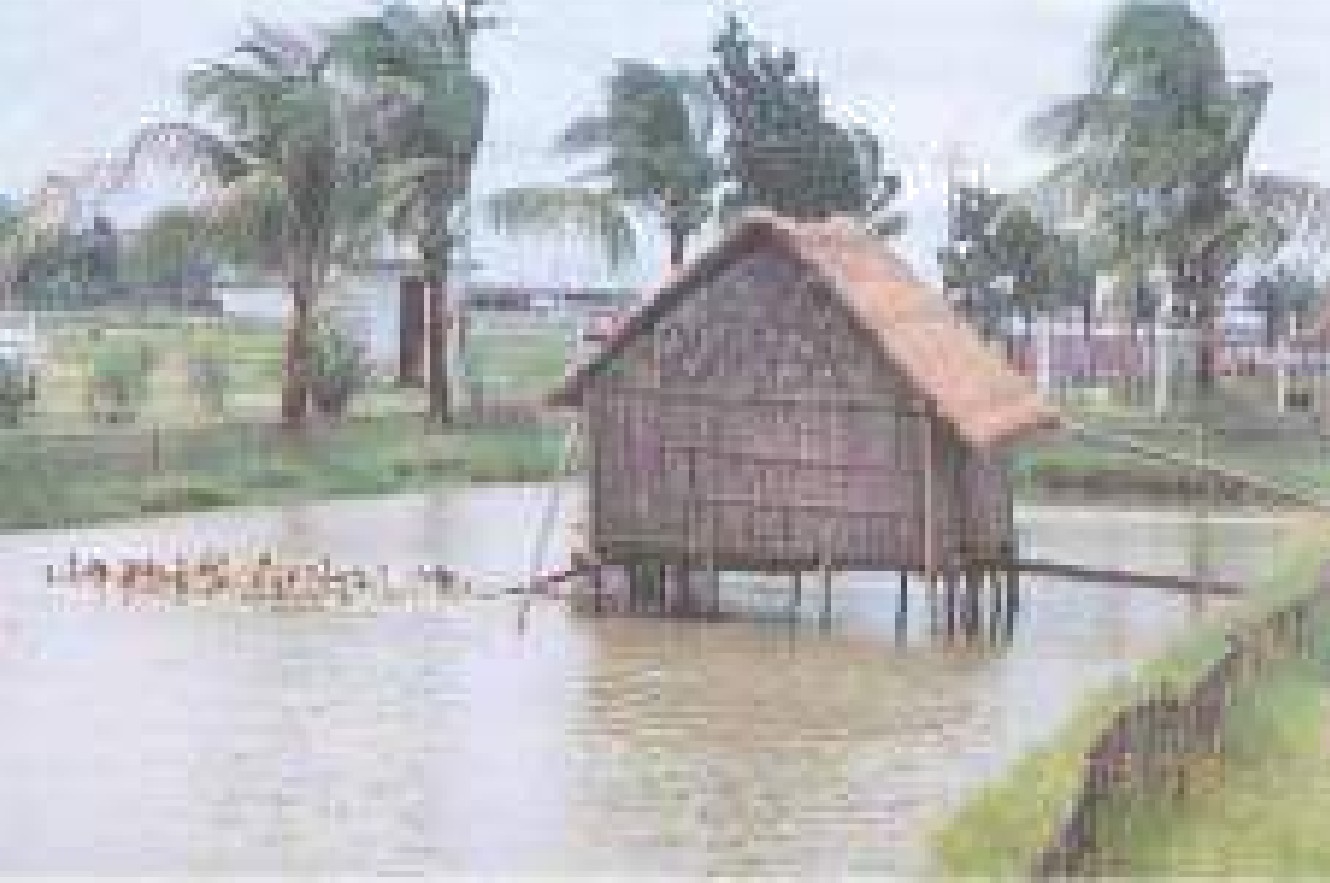
Poultry-fish farming
Poultry shed is constructed above the water level using bamboo pole so that droppings fertilize the fish pond directly. The bird is kept in confinement without access to outside. One bird requires a living space of 0.3-0.4 m2 inside the shed. In deep litter or battery system, the floor is covered with 10 cm thick layer of chopped straw, dry leaves, or groundnut shell. Rhode island red’ or fieghorn birds is preferred in the poultry-fish system because of its better growth rate and egg-laying capacity. The left over poultry feed, droppings, litter are used to sustain the biological productivity of the pond. One adult bird usually produces 25-30 kg of compost poultry droppings annually. Poultry droppings contain organic matter (25.5%), nitrogen (1.4%), phosphorus (0.8%) and potassium (0.6%). Poultry droppings @ 50 kg/ha/day is required, for which 500-1000 chicks have to be maintained in the farm.
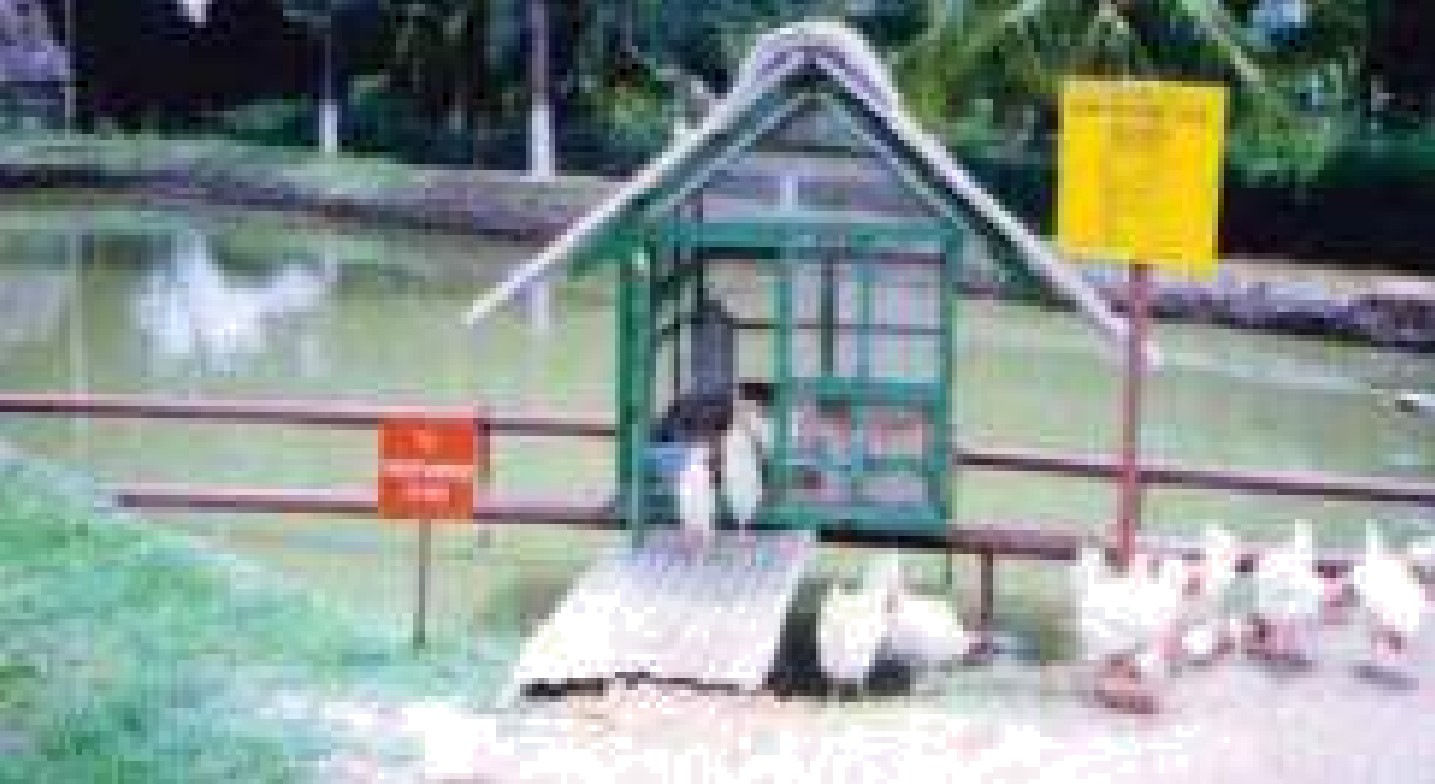
Cattle-fish farming
Cowshed is constructed in the vicinity of pond so that the slurry is directly discharged into it, which results in increased plankton production. A cattle weighing 400 kg provides about 400 kg of dung and 3500 litres of urine annually. The dung contain 14% organic matter, 0.3% nitrogen, 0.2% phosphorus and 0.1% potassium while the urine contain 2.3% organic matter, 1% nitrogen, 0.1% phosphorus and 1.4% potassium. For 1 ha of pond, 5-6 numbers of cows provide adequate quantity of dung and urine. Non-digested feed present in the dung is consumed directly by fish. The BOD of cattle dung is very low as it is already decomposed by microbes in the ruminant chamber. On an average, 4 t fish and 9,000 l milk are expected over a period of one year from 1 ha area.
Goat-fish farming
The suitable goat varieties are ’Surti’, ’Deccani’, Osmanabadi'and ’Malabari’. Goat is kept on elevated, pond dyke under a full spread shade tree, to protect them from sunlight. Adequate space, proper ventilation, good drainage facility and plenty of light are provided in the shed. Goats should not be opted for a marshy and swampy farm. The solid excreta of the goat is rich in nitrogen (2-3%) along with organic matter (60-70%), phosphorus (1.5-1.8%) and pottasium (2.3-3%). As it takes more time to decompose, there will not be any problem to keep BOD at the safe level. A healthy goat weighing 20 kg produces 300-400 g excreta on daily basis. In order to sustain the biological productivity of the pond, 50-60 numbers of goats are needed per hectare.
Pig-fish farming
It is one of the best integrated farming system in which the meat and fish are produced at a cheaper feed cost. The pig-sty is constructed over the pond in such a way that the wash-out can be directly drained into the pond. But there should be a provision to direct the same out of the pond when plankton production exceeds optimum level. Exotic breeds like ’White-Yorkshire’, ’Landrace' and ’Hampshire’ are suitable for integration with aquaculture. A living space of 3-4 m2 per animal is required in the pig-sty. The dung contain 15% organic matter, 0.6% nitrogen, 0.5% phosphorus and 0.4% potassium while the urine contain 2.5% organic matter, 0.4% nitrogen, 0.1% phosphorus and 0.7% potassium. An adult pig (70-90 kg) excretes 500-600 kg of dung annually. To fertilize the pond 30-45 no. of pigs per ha are required. Pig can also be fed with aquatic plants. After 6-8 months, pig attains a marketable size of 60-90 kg.
Rabbit-fish farming
Rabbit meat is comparatively low in fat content. Breeds like Grey giant white, New Zealand White and Soviet Chinchilla are suitable varieties. An adult rabbit produces 100 g excreta per day and the excreta contains organic matter (50-60%), nitrogen (2-3%),phosphorus (1-1.5%) and potassium (0.8-1.2%). The rabbit excreta contains 10 times more nitrogen than that of cow dung, releases nutrients gradually, helping to maintain high plankton production over a long period of time. Among the livestock, the rabbit has the highest reproduction rate. The rabbit cage is made of iron mesh net with roof sheet and installed over the dike close to the pond with a clearance of 2 feet from the top of the bundh. A floor space of 0.3 m2 is required per rabbit for a healthy environment. The young one should not be let-out of the cage. Rabbit attains a slaughter size of 3-4 kg within 6 months.
Rice-fish farming
In certain areas, paddy cultivation is limited to one crop per year, and the area remains fallow for the rest of the months. Fish farming in rice field provides off-season occupation and additional income. It needs a little modification of rice field such as digging of the peripheral trench, construction of nursery pond and strengthening of dyke. Under this system, the excessive growth of plankton, insect, mollusc and submerged and floating weeds are controlled by fish; otherwise, it adversely affects the rice cultivation. The faecal matter of fish fertilizes the field. Rice-fish farming can be done simultaneously or alternatively. In the simultaneous method, minimum water depth of 60 cm is maintained throughout the year, and the fish is kept in trenches during paddy cultivation. After paddy harvest, entire field is filled with more water upto a height of 1 m for smooth progress of fish culture.
In alternate/rotational culture, fish seed is initially stocked in nursery pond (requires 1% of field area) constructed in the field for the production of stunted seed of 50-100 g. One or two weeks after rice harvest, the field is prepared for fish culture and the stunted seeds are released at 3000 no./ha for grow-out rearing. One-third of total seeds shall be grass carp. The fish attains marketable size of 1 kg within 6 months.
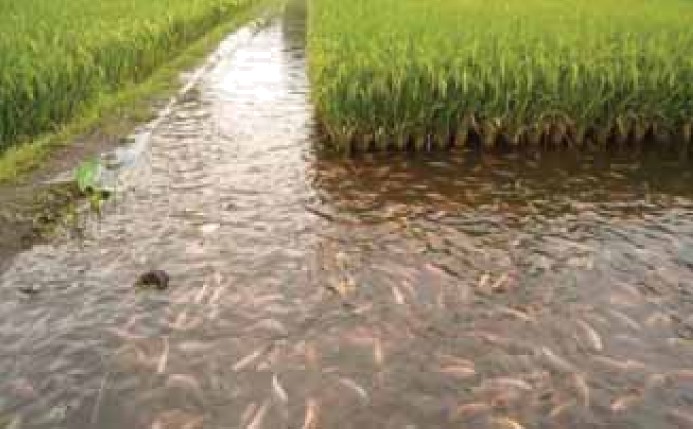
Horticulture-fish farming
The top, inner and outer dyke of the pond, as well as the adjacent space, is utilized for dwarf variety horticulture crop. The silt removed from the pond bottom rich in nutrients is used for horticulture crops. The residues of horticulture crop are given to fishes, particularly when stocked with grass carp and common carp. The pond water can be used for irrigation purposes.
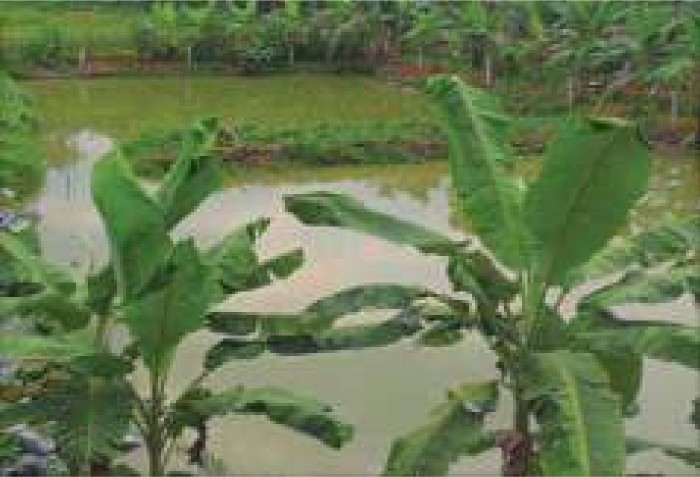
Coconut-fish farming
When coconut is cultivated in rows in wetlands, ditches not less than 70 cm in depth are made between such rows which act as supply or drainage canal. These canals serve as fish culture system owing to its round-the-clock water supply and rich insect population.
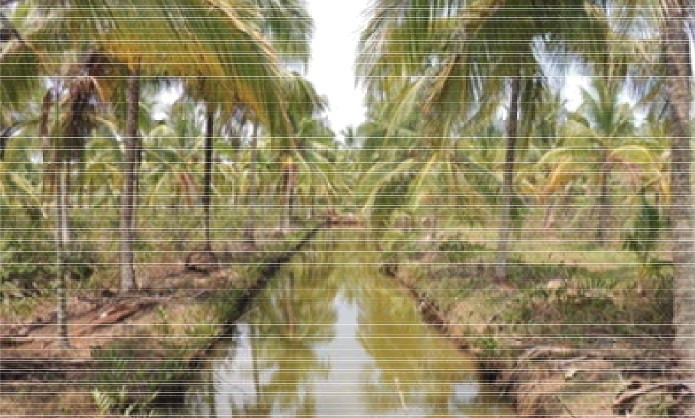
Source : Department of Fisheries
Last Modified : 12/28/2022
